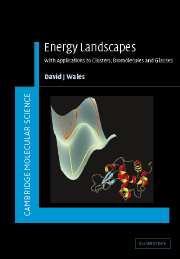Book contents
- Frontmatter
- Contents
- Preface
- 1 Introduction
- 2 The Born–Oppenheimer approximation and normal modes
- 3 Symmetry considerations
- 4 Features of the landscape
- 5 Describing the landscape
- 6 Exploring the landscape
- 7 Properties of the landscape
- 8 Clusters
- 9 Biomolecules
- 10 Glasses and supercooled liquids
- Appendix A Sylvester's law of inertia
- Appendix B Derivation of Ω(E, P, L)
- Index
4 - Features of the landscape
Published online by Cambridge University Press: 05 October 2013
- Frontmatter
- Contents
- Preface
- 1 Introduction
- 2 The Born–Oppenheimer approximation and normal modes
- 3 Symmetry considerations
- 4 Features of the landscape
- 5 Describing the landscape
- 6 Exploring the landscape
- 7 Properties of the landscape
- 8 Clusters
- 9 Biomolecules
- 10 Glasses and supercooled liquids
- Appendix A Sylvester's law of inertia
- Appendix B Derivation of Ω(E, P, L)
- Index
Summary
The most interesting points of a potential energy surface are usually the stationary (or critical) points where the gradient vanishes. The geometrical definitions of local minima and transition states on a potential energy surface are given in Section 4.1. Here we also explain how the definition of a transition state is related to alternative interpretations based on free energy or dynamical considerations. Symmetry properties of steepest-descent pathways are then examined in Section 4.2, and a classification scheme for rearrangement mechanisms is presented in Section 4.3. The symmetry restrictions imposed by these results upon possible reaction pathways are illustrated with a number of examples. Branch points and quantum tunnelling are considered in Section 4.4 and Section 4.5, with emphasis on the symmetry properties of the pathways involved. The invariance of the potential energy surface, stationary points and pathways to coordinate transformations is discussed in Section 4.6. Finally, in Section 4.7, we investigate the origin of zero Hessian eigenvalues, which reveals a fundamental difference between the translational and rotational degrees of freedom (1).
Classification of stationary points
A stationary point on a PES is a nuclear configuration where all the forces vanish, i.e. every component of the gradient vector is zero, ∂V(X)/∂Xα = 0 for 1 ≤ α ≤ 3N. Here, and subsequently, we will drop the ‘e’ subscript from V, which served to remind us in Chapter 2 that the potential energy surface describes the variation of the electronic energy with the nuclear coordinates within the Born–Oppenheimer approximation.
- Type
- Chapter
- Information
- Energy LandscapesApplications to Clusters, Biomolecules and Glasses, pp. 192 - 240Publisher: Cambridge University PressPrint publication year: 2004

